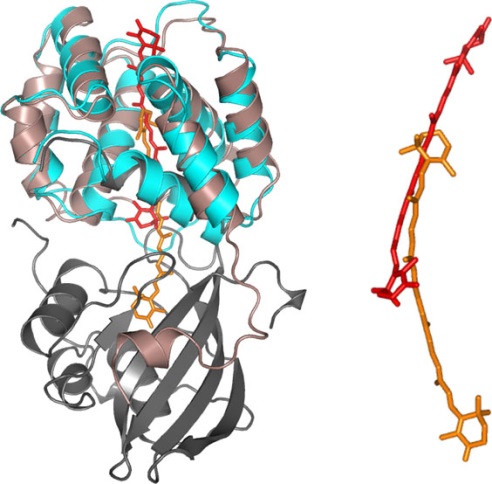Cyanobacteria (see box), like plants and algae, use light as a source of energy. However, too much light can be lethal for these photosynthetic organisms, due to the production of reactive oxygen species such as free radicals. To protect themselves from this phenomenon, cyanobacteria convert a part of the energy they collect into heat.
This photoprotection brings into play a recently discovered molecular mechanism, whose key element is a soluble photoactive protein: Orange Carotenoid Protein (OCP). This protein contains the pigment (i.e. a molecule capable of absorbing light) carotenoid. By combining sophisticated protein chemistry and genetics techniques, an international team involving INRA, the CEA-IBITECS and the CNRS has elucidated the three-dimensional structure of the active form of OCP. For the first time, the researchers have shown how the carotenoid carries out a significant change in position and conformation, by absorbing light. Indeed, the pigment shifts itself twelve angstroms (or twelve times one-tenth of a nanometer) at the interior of the OCP, and passes from an inactive orange form to an active red form. It is this movement which leads to a conformational change in the OCP and helps protect the cells from oxidative stress.
This work has made it possible to refine the knowledge of energy transfer mechanisms and photoprotection in cyanobacteria. It opens the way to an optimized use of these organisms for the production of biomass or biosourced compounds of industrial interest. They also enable envisioning the development of new energy production systems that use sunlight. Moreover, the use of OCP is promising in optogenetics (control of targeted enzymes and cellular activities by light) with applications in synthetic biology and in situ studies.

Three-dimensional representation of the OCP (Orange Carotenoid Protein) in its inactive form (gray) and its active form (sky blue), with the carotenoid at its center (orange or red). By shifting itself twelve angstroms at the interior of the OCP, the carotenoid (first in its orange form) displays a flatter shape and creates new interactions with the amino acids of the OCP (red form of the pigment). The C and N terminal domains of the OCP, thus far brought together by the carotenoid, now separate, making the OCP move towards an open conformation. The scientists have shown that OCP then proceeds to attach itself, by one of its sides, to the phycobilisome (i.e. the cyanobacterial antenna) and induces the thermal dissipation of the excess absorbed energy. © Diana Kirilovsky